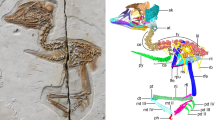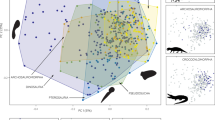Abstract
IN adult snakes the trabeculæ are the only elements of the chondrocranium which are present in the orbital region. They remain paired behind the level of the nasal capsule so that the chondrocranium is platytrabic.
This is a preview of subscription content, access via your institution
Access options
Subscribe to this journal
Receive 51 print issues and online access
$199.00 per year
only $3.90 per issue
Buy this article
- Purchase on Springer Link
- Instant access to full article PDF
Prices may be subject to local taxes which are calculated during checkout
Similar content being viewed by others
References
Parker, W. K., Phil. Trans. Roy. Soc., 169, 385 (1879).
De Beer, G. R., "The Development of the Vertebrate Skull" (Oxford, 1937).
Brock, G. T., Quart. J. Micr. Sci., 73, 289 (1929).
Author information
Authors and Affiliations
Rights and permissions
About this article
Cite this article
BELLAIRS, A. Orbital Cartilages in Snakes. Nature 163, 106–107 (1949). https://doi.org/10.1038/163106b0
Published:
Issue Date:
DOI: https://doi.org/10.1038/163106b0
Comments
By submitting a comment you agree to abide by our Terms and Community Guidelines. If you find something abusive or that does not comply with our terms or guidelines please flag it as inappropriate.



